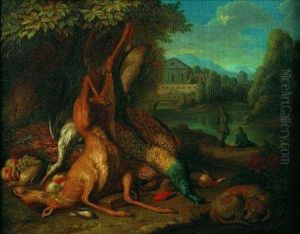Gerard Rysbrack Paintings
Gerard (also spelled as Gerrit or Gerhard) Rysbrack, born in Antwerp in 1694, was a prominent Flemish sculptor who gained considerable fame in 18th-century England. His full name, Johannes Franciscus Rysbrack, reflects his Flemish heritage, but it is in England where his artistic legacy primarily lies. Coming from a family with strong artistic roots—his father was a painter and his brother, Pieter Andreas Rysbrack, was also an artist—Gerard was well-primed for a career in the arts from an early age.
Rysbrack moved to London in 1720, where he quickly established himself as one of the leading sculptors, competing with contemporaries such as Louis-François Roubiliac. His work is characterized by a robust Baroque style, tempered with a sense of realism and detail that was highly prized in his time. Rysbrack's mastery in sculpting marble, bronze, and terracotta allowed him to excel in both monumental sculptures and smaller, intricate works. He was particularly renowned for his portrait busts, which captured the likenesses and personalities of his subjects with remarkable accuracy.
Throughout his career, Rysbrack received numerous commissions from the aristocracy and from institutions such as Westminster Abbey and the University of Oxford, reflecting the high regard in which he was held. His sculptures often featured historical and mythological themes, executed with a dramatic flair that was influenced by his Baroque roots. Notable works include the monument to Sir Isaac Newton in Westminster Abbey and the statues of King William III in Queen Square, Bristol, and of Hans Sloane in the Chelsea Physic Garden, London.
Rysbrack's influence extended beyond his lifetime, contributing significantly to the development of sculpture in Britain. He played a key role in the transition from the Baroque to the more classical style that would dominate the late 18th and early 19th centuries. Gerard Rysbrack passed away in 1770, leaving behind a legacy that cemented his position as one of the leading figures in British sculpture of the 18th century.
